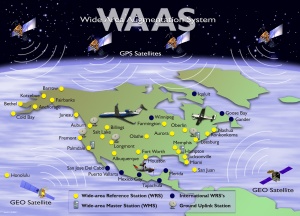If you wish to contribute or participate in the discussions about articles you are invited to contact the Editor
WAAS Ground Segment
| WAAS | |
|---|---|
| Title | WAAS Ground Segment |
| Author(s) | GMV. |
| Level | Basic |
| Year of Publication | 2011 |
The Wide Area Augmentation System (WAAS) is an GPS Augmentation system developed by the Federal Aviation Administration (FAA), with the goal of improving its accuracy, integrity, and availability. Essentially, WAAS is intended to enable aircraft to rely on GPS for all phases of flight, including precision approaches to any airport within its coverage area.
WAAS uses a network of ground-based reference stations, in North America and Hawaii, to measure small variations in the GPS satellites' signals in the western hemisphere. Measurements from the reference stations are routed to master stations, which queue the received Deviation Correction (DC) and send the correction messages to geostationary WAAS satellites in a timely manner (every 5 seconds or better). Those satellites broadcast the correction messages back to Earth, where WAAS-enabled GPS receivers use the corrections while computing their positions to improve accuracy.[1]
WAAS Ground Segment
The main layers of WAAS architecture are:
- WAAS Ground Segment: The ground segment is composed of multiple Wide-area Reference Stations (WRS). These precisely surveyed ground stations monitor and collect information on the GPS signals, then send their data to three Wide-area Master Stations (WMS). Using the data from the WRS sites, the WMSes compute precise differential corrections and integrity bounds, and send them to two pairs of Ground Uplink Stations (GUS), which then transmit to satellites in the Space segment for rebroadcast to the User segment.

